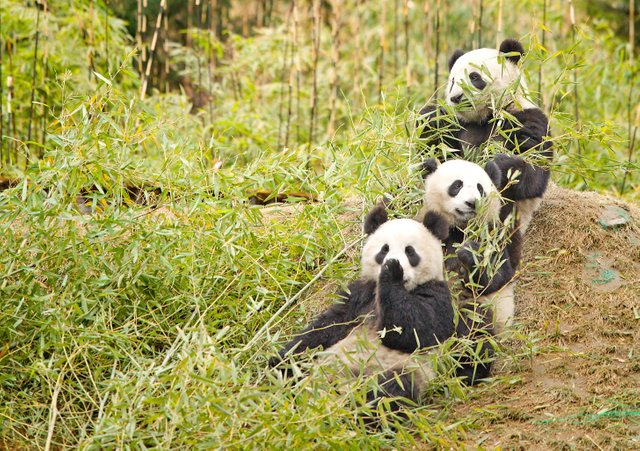Giant pandas (Ailuropoda melanoleuca) ate a varied diet only 5,000 years ago - much more recently than previously believed
Giant pandas (Ailuropoda melanoleuca) are a great example of animals that have adapted to fit an ecological niche and exploit that niche to thrive without competition. I am of course talking about how they only eat bamboo, a woody plant with a very low nutrient concentration.
Because of the low nutrient concentration within the bamboo shoots the giant pandas eat, they have to eat somewhere along the lines of 10 to 15 kilograms each day. This takes a long time to do, and it's no wonder that most wild giant pandas spend almost all of their time awake eating bamboo.

Three giant pandas eating bamboo. Photo by Chi King, posted with the CC BY 2.0 license.
One would assume that it would take a long time for an animal species to adapt to having such a specialized diet, and that's what panda researchers also believed for the longest time. So far the evidence of pandas adapting to specialization in eating bamboo has pointed towards sometime in the pleistocene epoch (commonly known as the Ice Age). This is not a good estimate for several reasons, including the fact that the pleistocene is an epoch that lasted over 2,500,000 years. It only ended 11,700 years ago, so it's a very uncertain estimate. It has also been debated within the panda research community, and a newly published research paper called "Diet Evolution and Habitat Contraction of Giant Pandas via Stable Isotope Analysis" by Han et al. (2019) puts giant pandas with a varied diet much closer to present than ever before.
Before we dig into the research, I want to clarify a few terms to make it less confusing. When I write a panda (species) , I am referring to the subfamily Ailuropodinae. This include the living giant panda, omnivorous pandas that resembled bears as we typically known them, as well as pandas that ate a varied diet of fruits and plants. When I talk about "modern pandas", I will refer to them as giant pandas, which is the commonly used name for Ailuropoda melanoleuca, the only species of panda that is still extant. So when I'm talking about a strictly bamboo-eating panda, I will use the term giant panda.
Comparing isotopes from modern giant pandas to those of ancient pandas
The group of Chinese researchers who published this paper found their results by comparing the stable isotope values of ancient pandas (and ancient giant pandas) against modern giant pandas to see if there was a dietary discrepancy between them.
The way this experiment works is that they measure the amount of an isotope of nitrogen in the bone collagen of the specimen, which will be dependent on several factors, and one of them is the diet. The research is based on measuring the level of nitrogen 15, a stable isotope of nitrogen. We have a very small amount of this isotope naturally occurring in the atmosphere, which means that plants and organisms who are capable of getting nitrogen from the atmosphere will this isotope in their proteins, since nitrogen is used for amino acids.
The method is a bit complex, but the short version is that different type of food would lead to a different amount of nitrogen-15 in their skeleton. For instance, a predatory panda would have higher levels of the nitrogen-15 isotopes since this isotope tend to bioaccumulate. A herbivorous panda that ate nutrient rich food would likely have a lower level, and the modern giant pandas that only eat bamboo were shown to have a smaller value than any other herbivore.
The point is that these isotopes can be used to make a kind of profile for the animals, and sudden shifts in this profile could be explained by something like a dietary change, a climatic change in the atmosphere, or the species changing where it lives.
During the research, the team saw that there was a shift in the nitrogen-15 profile for the giant pandas, and that there was a big difference between the ones who died in the last 40 years compared to the fossils that were as young as 5,000 years old. All the 5,000+ year old giant pandas had a much higher nitrogen-15 value than the modern giant pandas had.
There could be multiple reasons for this, and in order to get one step closer, the research team did the same test with other species of animals who have lived in the same regions in China. If there was something like a climatic shift that could explain the discrepancy, then surely other animal species in the region would have the same mismatch in their nitrogen-15 profiles.
It turns out that there was no mismatch for other species, and the team tested both herbivores and carnivores to see if either of these groups had experienced the same shift. None of them had.
This means that it was only the giant pandas that had this discrepancy, and the only possible reason the research team could think of to explain this was a change in their diet. There could of course be another variable that could explain the different values in nitrogen-15 in the skeleton, but for now the best guess is a change of diet.
So what did the ancient giant pandas eat?
While the stable isotope spectrometry is great for finding out if there is a different between samples, it's useless when it comes to determining why it is like that. As a matter of fact, no one really know exactly what they ate, but the levels of nitrogen-15 in their bones suggest a herbivorous diet. The carnivorous panda species (as well as the other carnivore species in the paper) had a higher levels than the ancient giant pandas, so we can feel fairly confident that the giant pandas were herbivores for a certain time before evolving to only eat nutrient-poor bamboo.

Who knows what they ate before beginning to eat this type of plant? Photo by Wikimmedia Commons user Tharish, posted with the CC BY-SA 3.0 license.
How could they adapt so fast?
We still have no idea how the giant pandas were able to evolve and adept to only eating bamboo in such as short time. Not only have they evolved a specialized digestive system to help them digest all that bamboo, they have also evolved a special pseudo-thumb that is perfect for using to eat bamboo. If that's not enough, their entire skull and teeth are perfectly designed to be great at eating bamboo.
There is currently no clear answer to this question, and the research group said in a press release that they hope to find more skeleton samples from the last 5,000 years to be able to determine exactly when they shifted to the specialized diet. Finding exactly when the giant pandas began to specialize in eating bamboo will make it much easier to figure out how, and even why.
Sources
This post was based on the paper Diet Evolution and Habitat Contraction of Giant Pandas via Stable Isotope Analysis by Han et al. (2019), published in Current Biology.
Thanks for reading
I hope you enjoyed learning a bit more about the evolution of pandas. Thanks for stopping by, and make sure to leave questions or comments below!
Relatively common in forensic and food science, but this is a seriously interesting approach for Pandas.
I've learned something new. Thanks!
Thanks for stopping by, @alexs1320. I'm glad you learned something new!
I didn't know that it was used for forensic and food sciences, but that makes sense. I have seen it being used to determining the exact trophic level of organisms in biology before as well, but this is the first time I have seen it being used to see a big shift in the diet.
Great to read form you again. This was a long time and your posts are always interesting (as the comment from @alexs1320)! I hope you will restart posting regularly :)
Thanks for saying that, @lemouth. I would love to start posting more regularly again, but unfortunately I don't really have much free time these days. But I'm not going to be leaving this blockchain anytime soon, so I will do my best to write a post every once in a while :)
I know the feeling about time... I would love so much to post more... I will try to cook up smth tomorrow ;)
That's quite interesting (and clearly written!) I wonder whether we can draw some hypothetical conclusions regarding humans, and how quickly it was possible for us to adapt to eating gluten etc., contra to the paleo diet proponents.
That's an interesting thing to speculate. I guess we could do something similar with humans as well, but it would be much more difficult since we eat a lot of different things. Bamboo has a very unique profile, so it's easy to determine something as "not bamboo", rather than identifying exactly what it is.
Lovely animals
Yes, they sure are :)
To listen to the audio version of this article click on the play image.

Brought to you by @tts. If you find it useful please consider upvoting this reply.
Congratulations @valth! You have completed the following achievement on the Steem blockchain and have been rewarded with new badge(s) :
Click here to view your Board
If you no longer want to receive notifications, reply to this comment with the word
STOPThis post has been voted on by the SteemSTEM curation team and voting trail in collaboration with @utopian-io and @curie.
If you appreciate the work we are doing then consider voting all three projects for witness by selecting stem.witness, utopian-io and curie!
For additional information please join us on the SteemSTEM discord and to get to know the rest of the community!
Hi @valth!
Your post was upvoted by @steem-ua, new Steem dApp, using UserAuthority for algorithmic post curation!
Your UA account score is currently 5.205 which ranks you at #852 across all Steem accounts.
Your rank has improved 1 places in the last three days (old rank 853).
In our last Algorithmic Curation Round, consisting of 265 contributions, your post is ranked at #112.
Evaluation of your UA score:
Feel free to join our @steem-ua Discord server
Hi @valth!
Your post was upvoted by Utopian.io in cooperation with @steemstem - supporting knowledge, innovation and technological advancement on the Steem Blockchain.
Contribute to Open Source with utopian.io
Learn how to contribute on our website and join the new open source economy.
Want to chat? Join the Utopian Community on Discord https://discord.gg/h52nFrV
Very interesting article. Evolution and adaptation is quite difficult to comprehend. Some species seem to not change for millions of years, their genetic make up is so stable. Others can change in just a few thousand years.
Do you have special interests in animals / biology?